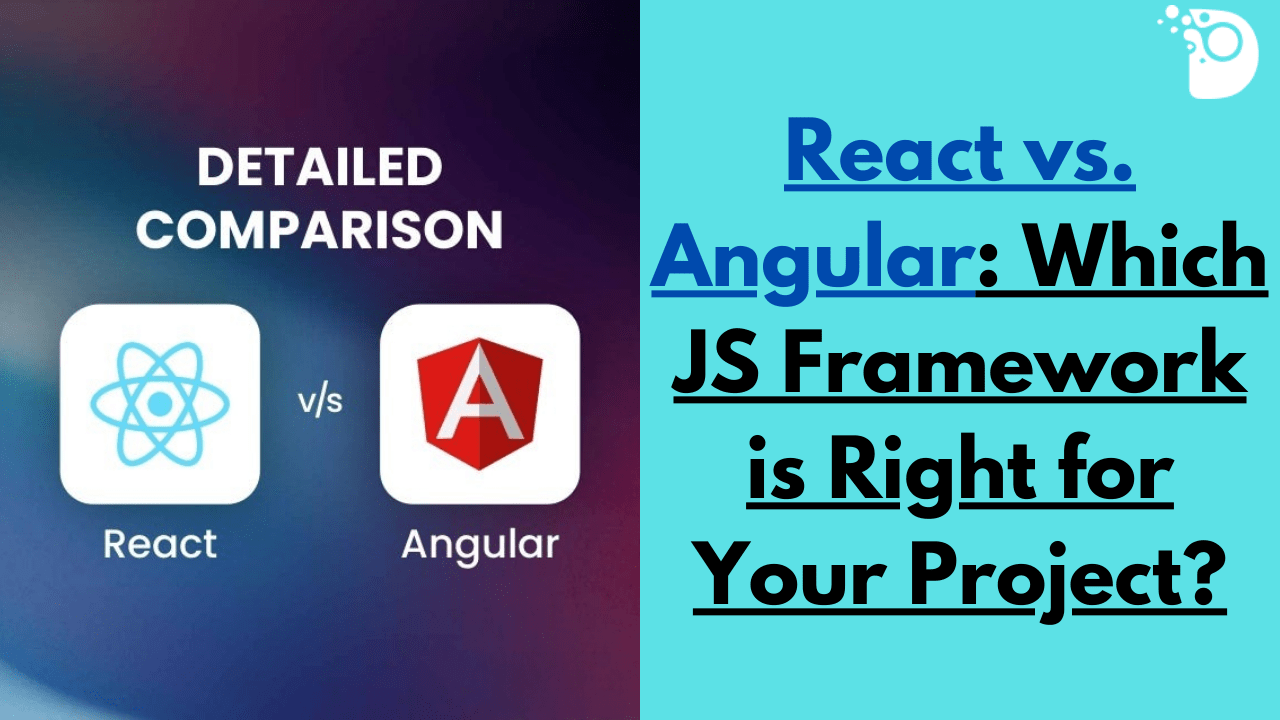Choosing the right JavaScript framework for your project can be monumental. With all of the available options, you’re usually forced to pick one of the two biggest: React vs. Angular. Both have unique strengths and weaknesses, and the best choice largely depends on your specific project needs. In this blog, we’ll go deep into both React and Angular to help you make an informed decision.
Getting to Know the Basics
Before we dive deep into the comparison, let’s do a quick run-down of what each framework offers.
React
React, a JavaScript library from Facebook, is built mainly for the purpose of building user interfaces. It focuses on the creation of reusable UI components and should be a game-changer for flexibility and speed in development. According to sources, React is supposed to be development-efficient, based on virtual DOM and one-way data binding, for making applications dynamic.
Angular
Angular is a full-featured JS framework produced by Google. It’s like an all-in-one framework solution, including routing and form handling up to complex applications, providing an all-in-one solution. Angular has a real DOM and works with two-way data binding, which comes in quite powerful in complex applications but can be resource-demanding in some cases.
React vs Angular: A Full Comparison
Now that we have a basic understanding of both frameworks, let’s have a side-by-side comparison on React vs. Angular regarding some of the most important features.
Why Choose React?
Flexibility
React offers a maximum amount of flexibility that can be offered by a JavaScript library during its development. Developers can craft an opinion about whether to use whatever library or tool to imply when the decision arises while taking care of things like routing or state management. Which can mean that React JS is good for projects envisioning custom solutions.
With the help of a virtual DOM, the React workflows become super swift in cases with great collections of dynamic information
Learning Curve
Considering that you are a beginner to front-end development or even to JavaScript frameworks, React is more approachable. But, at the same time, it is quite a simple library with a view layer, which makes it easy to learn and implement compared to a parallel full-fledged framework like Angular.
Large Ecosystem
React has a strong ecosystem that supports many third-party libraries, tools, and plugins. An active community continually works to make React better and resources are available for learning and problem-solving.
Why Choose Angular?
Complete
Angular development is a full-on package. With routing and HTTP services and form validation coming out-of-the-box, there are lots of features that are non-essential in Angular, which will otherwise be third-party libraries adding to the work. That’s what would make Angular a framework of preference for things like enterprise-level projects, which need a kind of ‘from the box’ solution.
Two-Way Data Binding
Where a model and view need to remain continuously synchronized, two-way data binding in Angular simplifies everything and requires developers to write very little code to achieve the same. This enables a developer to update most applications with fewer manual DOM manipulations, which can be quite strenuous.
Structured Development
This can be a big boon for developers when it comes to organizing and structuring the code. Angular has a structure, and as such, there is a clear guideline provided for a proper architecture. Hence, it would be good for large teams and exemplary projects since this means there will be consistency across the sectors.
Strong Community and Support
Good official documentation, a strong community of developers, and consistent support from Google through regular updates make Angular one of the best options for big projects.
Elevate your online presence with our top-tier front-end development services—where innovation meets user experience.
Conclusion: Which one would you pick?
So which one of these should be selected in the React vs. Angular debate? Well, in conclusion, it just depends on your project requirements.
React is like a good choice for developing a lightweight or small-to-medium project for both, when looking at the aspect of flexibility and performance. On the other side, working with large enterprise-level applications for a one-stop solution, Angular should be a better choice.
So, in conclusion, both frameworks have unique strengths, and your choice between them will majorly depend on your particular needs, the expertise of your team, the goals of the project, among many other things. Whatever be your choice, React and Angular are unarguably top-class tools vouched for by the web development community.
Frequently Asked Questions (FAQs)
Q1: What is the main difference between React and Angular?
Ans: The primary difference lies in their nature and scope. React is a JavaScript library focused on building user interfaces and is particularly good for developing single-page applications (SPAs). It uses a virtual DOM for better performance and offers more flexibility, allowing developers to integrate various libraries for additional functionalities. Angular, on the other hand, is a full-fledged framework developed by Google that provides a comprehensive solution for building complex applications. It includes features like two-way data binding and a robust dependency injection system.
Q2: Which framework offers better performance, React or Angular?
Ans: React generally offers better performance for dynamic applications due to its virtual DOM, which efficiently updates only the parts of the UI that have changed. This minimizes the amount of DOM manipulation and boosts overall speed. Angular uses a real DOM and two-way data binding, which can be less performant in scenarios with frequent updates or complex UI structures. However, Angular’s performance can still be optimized with techniques like Ahead-of-Time (AOT) compilation and lazy loading.
Q3: What is the learning curve like for React vs. Angular?
Ans: React has a gentler learning curve, especially if you are already familiar with JavaScript and ES6 features. It focuses primarily on the view layer, making it easier to grasp. Angular has a steeper learning curve due to its extensive features and complex architecture. It requires understanding TypeScript, dependency injection, and Angular’s specific concepts, which might be challenging for beginners.
Q4: How do React and Angular handle data binding?
Ans: React uses one-way data binding, where data flows in a single direction from the model to the view. This makes it easier to track data flow and debug issues. Angular utilizes two-way data binding, which synchronizes the model and the view automatically. While this can simplify development for complex forms and applications, it may also introduce additional performance overhead.
Q5: Which framework is more suitable for large-scale applications?
Ans: Angular is often preferred for large-scale enterprise applications due to its comprehensive nature. It provides built-in solutions for routing, form management, and state management, which can be advantageous for complex projects. React can also be used for large-scale applications, but it may require integrating additional libraries and tools to match Angular’s built-in capabilities.






